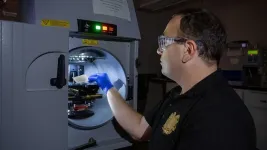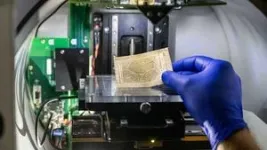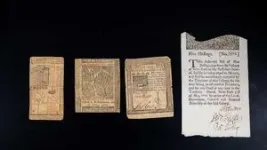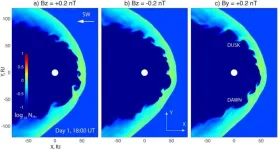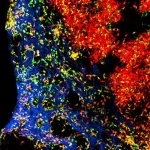(Press-News.org) Benjamin Franklin may be best known as the creator of bifocals and the lightning rod, but a group of University of Notre Dame researchers suggest he should also be known for his innovative ways of making (literal) money.
During his career, Franklin printed nearly 2,500,000 money notes for the American Colonies using what the researchers have identified as highly original techniques, as reported in a study published this week in the Proceedings of the National Academy of Sciences.
The research team, led by Khachatur Manukyan, an associate research professor in the Department of Physics and Astronomy, has spent the past seven years analyzing a trove of nearly 600 notes from the Colonial period, which is part of an extensive collection developed by the Hesburgh Libraries’ Rare Books and Special Collections. The Colonial notes span an 80-year period and include notes printed by Franklin’s network of printing shops and other printers, as well as a series of counterfeit notes.
Manukyan explained that the effort to print money for the fledgling Colonial monetary system was important to Franklin not just as a printer but as a statesman as well.
“Benjamin Franklin saw that the Colonies’ financial independence was necessary for their political independence. Most of the silver and gold coins brought to the British American colonies were rapidly drained away to pay for manufactured goods imported from abroad, leaving the Colonies without sufficient monetary supply to expand their economy,” Manukyan said.
However, one major problem stood in the way of efforts to print paper money: counterfeiting. When Franklin opened his printing house in 1728, paper money was a relatively new concept. Unlike gold and silver, paper money’s lack of intrinsic value meant it was constantly at risk of depreciating. There were no standardized bills in the Colonial period, leaving an opportunity for counterfeiters to pass off fake bills as real ones. In response, Franklin worked to embed a suite of security features that made his bills distinctive.
“To maintain the notes’ dependability, Franklin had to stay a step ahead of counterfeiters,” said Manukyan. “But the ledger where we know he recorded these printing decisions and methods has been lost to history. Using the techniques of physics, we have been able to restore, in part, some of what that record would have shown.”
Manukyan and his team employed cutting-edge spectroscopic and imaging instruments housed in the Nuclear Science Laboratory and four Notre Dame research core facilities: the Center for Environmental Science and Technology, the Integrated Imaging Facility, the Materials Characterization Facility and the Molecular Structure Facility. The tools enabled them to get a closer look than ever at the inks, paper and fibers that made Franklin’s bills distinctive and hard to replicate.
One of the most distinctive features they found was in Franklin’s pigments. Manukyan and his team determined the chemical elements used for each item in Notre Dame’s collection of Colonial notes. The counterfeits, they found, have distinctive high quantities of calcium and phosphorus, but these elements are found only in traces in the genuine bills.
Their analyses revealed that although Franklin used (and sold) “lamp black,” a pigment created by burning vegetable oils, for most printing, Franklin’s printed currency used a special black dye made from graphite found in rock. This pigment is also different from the “bone black” made from burned bone, which was favored both by counterfeiters and by those outside Franklin’s network of printing houses.
Another of Franklin’s innovations was in the paper itself. The invention of including tiny fibers in paper pulp — visible as pigmented squiggles within paper money — has often been credited to paper manufacturer Zenas Marshall Crane, who introduced this practice in 1844. But Manukyan and his team found evidence that Franklin was including colored silks in his paper much earlier.
The team also discovered that notes printed by Franklin’s network have a distinctive look due to the addition of a translucent material they identified as muscovite. The team determined that Franklin began adding muscovite to his papers and the size of this muscovite crystals in his paper increased over time. The team speculates that Franklin initially began adding muscovite to make the printed notes more durable but continued to add it when it proved to be a helpful deterrent to counterfeiters.
Manukyan said that it is unusual for a physics lab to work with rare and archival materials, and this posed special challenges.
“Few scientists are interested in working with materials like these. In some cases, these bills are one-of-a-kind. They must be handled with extreme care, and they cannot be damaged. Those are constraints that would turn many physicists off to a project like this,” he said.
But for him, the project is a testament to the value of interdisciplinary work.
“We were fortunate to have student researchers on this project with interests both in physics as well as in history and art conservation. And the core research facilities as well as the Rare Books and Special Collections team were incredible research partners. Without an uncommon level of collaboration across disciplines, our discoveries would not have been possible.”
In addition to lead investigator Manukyan, the research team for this project included Armenuhi Yeghishyan, a laboratory technician in the Department of Physics and Astronomy; Ani Aprahamian, the Frank M. Freimann Professor of Physics and concurrent professor in the Department of Chemistry and Biochemistry; Louis Jordan, an associate University librarian emeritus for academic services and collections; Michael Kurkowski, a former undergraduate researcher studying physics and mathematics; Mark Raddell, a former undergraduate researcher studying finance and physics who is now a consultant at Deloitte; Laura Richter Le, a former undergraduate researcher who is now a graduate student at the Conservation Center at New York University’s Institute of Fine Arts; Zachary D. Schultz, a former associate professor at Notre Dame who is now a faculty member at the Ohio State University; Liam Spillane, who works at Gatan Inc.; and Michael Wiescher, the Frank M. Freimann Professor of Physics.
This research project was funded by an internal grant from Notre Dame Research. For more information on the Nuclear Science Laboratory’s work investigating historical materials, visit sites.nd.edu/kmanukyan/research/.
END
All about the Benjamins: Researchers decipher the secrets of Benjamin Franklin’s paper money
A rare window into the early American monetary history — thanks to techniques from physics
2023-07-17
ELSE PRESS RELEASES FROM THIS DATE:
Redlining linked to higher heart failure risk among Black adults in US
2023-07-17
Research Highlights:
An analysis of more than two million adults in the U.S. found that present day heart failure risk was higher among Black adults who lived in zip codes historically impacted by redlining compared to Black adults living in non-redlined areas.
Redlining did not have the same impact on heart failure risk among white adults living in historically redlined zip codes.
Among Black adults living in historically redlined communities, approximately half of the excess risk of heart failure appeared to be explained by higher levels of socioeconomic distress.
Embargoed until 1 p.m. CT/2 p.m. ET Monday, July 17, ...
Racial disparities discovered in patients with cardiac devices
2023-07-17
Black patients with implantable cardioverter defibrillators (ICDs) have a significantly higher burden of disease than white patients with the same device, according to a new study from University of Rochester Medical Center (URMC) cardiology researchers. Analyzing data from clinical trials conducted over a 20-year period by the Clinical Cardiovascular Research Center (CCRC) at URMC, investigators concluded that not only did Black patients with ICDs tend to be significantly younger than white patients, but they also had a higher ...
SwRI team identifies giant swirling waves at the edge of Jupiter’s magnetosphere
2023-07-17
SAN ANTONIO — July 17, 2023 —A team led by Southwest Research Institute (SwRI) and The University of Texas at San Antonio (UTSA) has found that NASA’s Juno spacecraft orbiting Jupiter frequently encounters giant swirling waves at the boundary between the solar wind and Jupiter’s magnetosphere. The waves are an important process for transferring energy and mass from the solar wind, a stream of charged particles emitted by the Sun, to planetary space environments.
Jake Montgomery, a doctoral student in the joint space physics program ...
Immune cells in single file
2023-07-17
The cells of the immune system circulate mainly in the blood and migrate into the body's tissues after an inflammation. Some types of immune cells, however, are permanently located in the tissues, where they come together to form three-dimensional networks.
How do these networks form and how are they maintained? For the long-lived macrophages (phagocytes), the answer is already known: They settle in so-called niches. These are environments of connective tissue cells that supply the macrophages with nutrients and keep them ...
New research shows babies’ immunological weak spot and strength
2023-07-17
NEW YORK, NY--A pair of new studies led by researchers at Columbia University explains why babies get so many common respiratory infections and identifies a specialized cluster of immune cells found only in babies that help them better cope with new pathogens.
“We know little about how the immune system develops throughout life, and most of what we know about immune system development in children comes from animal studies,” says Donna Farber, PhD, an expert in immune system development at Columbia University ...
National Poll: Less than half of parents utilize patient portal benefits for their children
2023-07-17
ANN ARBOR, Mich. – For many busy families, online access to a child’s health provider for medical advice, health records or prescription refills is likely a convenient option.
Yet, only 43% of parents have set their child up for a patient portal – an online tool allowing communication between patients and medical providers – and others may not be optimizing portal use, suggests the University of Michigan Health C.S. Mott Children’s Hospital National Poll on Children’s Health.
“Patient portals offer a wide range of benefits, including decreasing unnecessary hassles for providers and patients and improving access to both the medical ...
The missing Americans: Unprecedented US mortality far exceeds other wealthy nations
2023-07-17
FOR IMMEDIATE RELEASE
Monday, July 17, 2023
Contact:
Jillian McKoy, jpmckoy@bu.edu
Michael Saunders, msaunder@bu.edu
##
The Missing Americans: Unprecedented US Mortality Far Exceeds Other Wealthy Nations
A new study found that more than one million US deaths a year—including many young and working-age adults—could be avoided if the US had mortality rates similar to its peer nations.
In 2021, 1.1 million deaths would have been averted ...
Addressing the future challenges of global surface water quality
2023-07-17
As the world's population continues to grow, ensuring access to clean and safe water has become an increasingly important concern, yet little is known about how surface water quality will change in the future. Recent scientific research has shed light on the potential challenges that surface water quality may face in the coming years, particularly in Sub-Saharan Africa. “While surface water quality is projected to improve in most developed countries, there is an important caveat: the outlook for the poorest nations is bleak”.
A recent study, published in Nature Water, has projected an increase in surface water pollution in Sub-Saharan Africa. These findings ...
Study finds how to reduce risk of kids playing with a found gun
2023-07-17
COLUMBUS, Ohio – In a lab at The Ohio State University masquerading as a playroom, pairs of kids ages 8 to 12 participating in a study found a variety of toys and games to play with – as well as a mysterious file cabinet.
Inside one of the drawers of the unlocked cabinet were two disabled 9-mm handguns.
As they played in the room, nearly all the children eventually found the guns. But some kids in the study were much more likely to tell an adult they found a gun, less likely to touch the gun, and were less reckless if they did touch it – and they were the kids who had watched a one-minute gun safety video a week earlier.
The study may be the ...
Trading sickness for health: Swapping brain cells points to new Huntington's therapies
2023-07-17
NNew research appearing in the journal Nature Biotechnology answers important questions about the viability of treatments that seek to replace diseased and aged cells in the central nervous system with healthy ones. Its findings have implications for a number of neurological and psychiatric disorders—including Huntington’s disease, amyotrophic lateral sclerosis (ALS), and schizophrenia—that have been linked to glia, a population of cells that support brain health and function.
“A broad variety of disorders we associate with neuronal loss now appear to be caused ...
LAST 30 PRESS RELEASES:
Germline pathogenic variants among women without a history of breast cancer
Tanning beds triple melanoma risk, potentially causing broad DNA damage
Unique bond identified as key to viral infection speed
Indoor tanning makes youthful skin much older on a genetic level
Mouse model sheds new light on the causes and potential solutions to human GI problems linked to muscular dystrophy
The Journal of Nuclear Medicine ahead-of-print tip sheet: December 12, 2025
Smarter tools for peering into the microscopic world
Applications open for funding to conduct research in the Kinsey Institute archives
Global measure underestimates the severity of food insecurity
Child survivors of critical illness are missing out on timely follow up care
Risk-based vs annual breast cancer screening / the WISDOM randomized clinical trial
University of Toronto launches Electric Vehicle Innovation Ontario to accelerate advanced EV technologies and build Canada’s innovation advantage
Early relapse predicts poor outcomes in aggressive blood cancer
American College of Lifestyle Medicine applauds two CMS models aligned with lifestyle medicine practice and reimbursement
Clinical trial finds cannabis use not a barrier to quitting nicotine vaping
Supplemental nutrition assistance program policies and food insecurity
Switching immune cells to “night mode” could limit damage after a heart attack, study suggests
URI-based Global RIghts Project report spotlights continued troubling trends in worldwide inhumane treatment
Neutrophils are less aggressive at night, explaining why nighttime heart attacks cause less damage than daytime events
Menopausal hormone therapy may not pose breast cancer risk for women with BRCA mutations
Mobile health tool may improve quality of life for adolescent and young adult breast cancer survivors
Acupuncture may help improve perceived breast cancer-related cognitive difficulties over usual care
Nerve block may reduce opioid use in infants undergoing cleft palate surgery
CRISPR primes goldenberry for fruit bowl fame
Mass General Brigham announces new AI company to accelerate clinical trial screening and patient recruitment
Fat tissue around the heart may contribute to greater heart injury after a heart attack
Jeonbuk National University researcher proposes a proposing a two-stage decision-making framework of lithium governance in Latin America
Chromatin accessibility maps reveal how stem cells drive myelodysplastic progression
Cartilaginous cells regulate growth and blood vessel formation in bones
Plant hormone allows lifelong control of proteins in living animal for first time
[Press-News.org] All about the Benjamins: Researchers decipher the secrets of Benjamin Franklin’s paper moneyA rare window into the early American monetary history — thanks to techniques from physics
